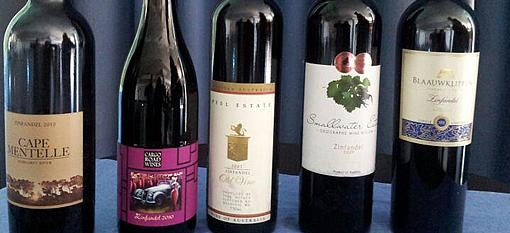The 6th annual Blaauwklippen International Zinfandel tasting took place at the Raddison Blu Hotel in Cape Town not to long ago and this year cellar master, Rolf Zeitvogel compared Australian Zinfandel examples to that of Blaauwklippen.
Zinfandel is red grape originally from Italy where it is known as Primitivo. Over the last couple of years saw a steadily growing interest in Australia, where about 70 wineries are producing the variety. In South Africa however only a hand full of wine producers are brave enough to tackle this lesser known grape varietal, with Blaauwklippen taking the lead by producing not one, but four products under its Zinfandel range.
“Zinfandel is a unique selling point for Blaauwklippen, and we are committed to build on the legacy that was left to us by Walter Finalyson and his team, when they planted the very first Zinfandel vines on the farm in the late seventies.” says Rolf.
The Zinfandel, Zinfandel Reserve, White Zinfandel and a Noble Late Harvest Zinfandel went up against some expensive and well-known Australian Zinfandels. The four Australian Zinfandel wines we tasted were:
- The Cape Mentelle 2010 from the west coast Margaret River wine region. According to some this is the best Zinfandel producer in Australia and the first vineyard was planted back in 1974.
- The Cargo Road 2010, made from one of the older Australian Zinfandel blocks. The vines were planted in 1983 and is based in Mount Canobolas. This particular wine was my least favourite out of the lot. The nose was overbearing and did nothing to enhance the over-ripe fruit flavours of the wine.
- The Smallwater Estate 2009 comes from the south west region, known as one of Australia’s most reliable wine growing areas. This wine was by far the best out of the four Austrian Zinfandel and comes with a hefty price-tag.
- The Peel Estate 2007, produced in Karnup, situated 70 km south of Perth. The vineyard is located only 3 km from the ocean, which has a great impact on the grapes, with mild winters and cool coastal breezes in summer. The alcohol level on this wine is similar to that of a port at 17.5%.
 The Blaauwklippen Zinfandel Reserve 2011 did not have to stand back for any of the above mentioned wines. Intense canopy management is practised in the vineyard with a crop of only 4,5 – 5 tonnes per ha. The wine is fermented in French Oak barrels for at least 18 months and displays rich plum and vanilla spice flavours with whiffs of cigarbox and bitter chocolate. As the saying goes, ”good things don’t come cheap”. The wine retails at R300 a bottle from the cellar door and when taking in consideration the great care and time that goes into the making of the wine, it’s by no mean an unreasonable price to pay.
The Blaauwklippen Zinfandel Reserve 2011 did not have to stand back for any of the above mentioned wines. Intense canopy management is practised in the vineyard with a crop of only 4,5 – 5 tonnes per ha. The wine is fermented in French Oak barrels for at least 18 months and displays rich plum and vanilla spice flavours with whiffs of cigarbox and bitter chocolate. As the saying goes, ”good things don’t come cheap”. The wine retails at R300 a bottle from the cellar door and when taking in consideration the great care and time that goes into the making of the wine, it’s by no mean an unreasonable price to pay.


